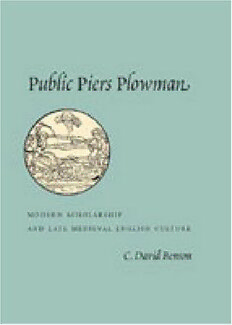
Public Piers Plowman: Modern Scholarship and Late Medieval English Culture PDF
304 Pages·2004·1.168 MB·English
Most books are stored in the elastic cloud where traffic is expensive. For this reason, we have a limit on daily download.
Preview Public Piers Plowman: Modern Scholarship and Late Medieval English Culture
Description:
The fourteenth-century alliterative poem Piers Plowman was widely popular in its own day. The number of its surviving manuscripts ranks just below that of Chaucer?’s Canterbury Tales. Although the poem has been the subject of some interesting recent critical scholarship, it continues to be marginalized by medievalists and non-medievalists alike. According to C. David Benson, this is because the tendency of modern criticism has been to read Piers as an autobiography mired in the singular intellectual obsessions of its author or as a recondite exploration of theological and political issues. In Public Piers Plowman, Benson returns the poem to the center of late medieval English culture by treating it as a public rather than a personal or elite work. Public Piers Plowman is divided into two parts. The first is an extended essay on what Benson calls the "Langland myth." He traces the evolution of Piers scholarship and demonstrates the limitations of treating Piers as a direct expression of the poet?’s life and intellectual views. Well over a century after its creation, the Langland myth remains dominant in studies of the poem, blocking other potentially fruitful approaches. In the second part Benson offers an alternative history for the poem. Although Piers is usually compared with high art and thought, such as that of Chaucer or scholasticism, Benson approaches it from a broader public context, using representative examples from vernacular writing, parish art, and civic practices. He argues that Piers reached a wide contemporary audience because, far from being an expression of the author?’s own life and opinions, it was securely rooted in the common culture of its time and place. Public Piers Plowman is an ambitious work that dares to confront a true literary masterpiece. In the process, it makes this great poem more accessible, exciting, and necessary to modern readers.
See more
The list of books you might like
Most books are stored in the elastic cloud where traffic is expensive. For this reason, we have a limit on daily download.
